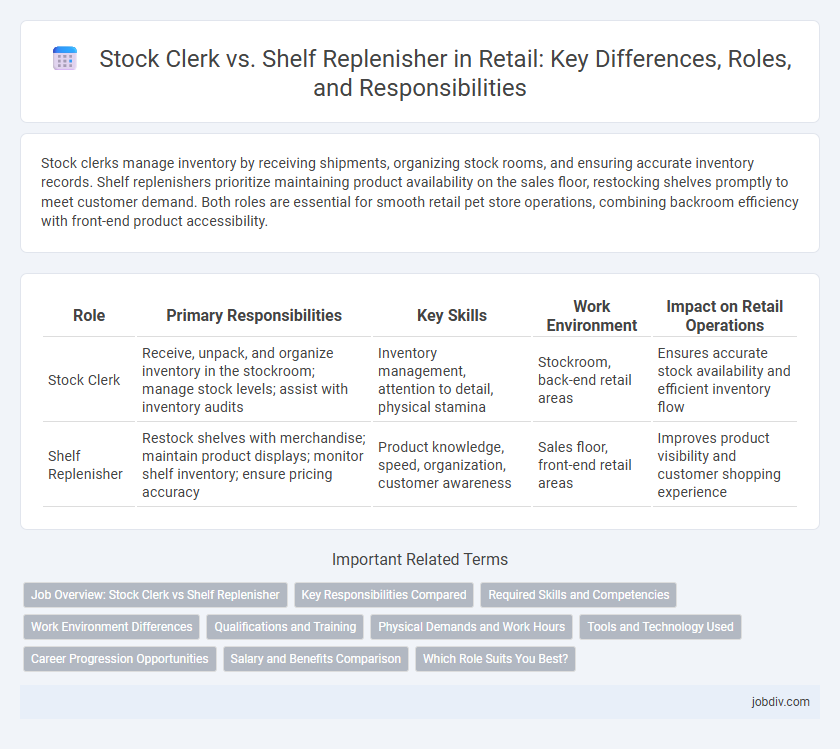Stock clerks manage inventory by receiving shipments, organizing stock rooms, and ensuring accurate inventory records. Shelf replenishers prioritize maintaining product availability on the sales floor, restocking shelves promptly to meet customer demand. Both roles are essential for smooth retail pet store operations, combining backroom efficiency with front-end product accessibility.
Table of Comparison
| Role | Primary Responsibilities | Key Skills | Work Environment | Impact on Retail Operations |
|---|---|---|---|---|
| Stock Clerk | Receive, unpack, and organize inventory in the stockroom; manage stock levels; assist with inventory audits | Inventory management, attention to detail, physical stamina | Stockroom, back-end retail areas | Ensures accurate stock availability and efficient inventory flow |
| Shelf Replenisher | Restock shelves with merchandise; maintain product displays; monitor shelf inventory; ensure pricing accuracy | Product knowledge, speed, organization, customer awareness | Sales floor, front-end retail areas | Improves product visibility and customer shopping experience |
Job Overview: Stock Clerk vs Shelf Replenisher
Stock clerks manage inventory by receiving, organizing, and tracking products in the stockroom to ensure accurate stock levels, while shelf replenishers focus on transferring items from storage to store shelves to maintain product availability for customers. Stock clerks often use inventory management systems and perform quality checks, whereas shelf replenishers prioritize timely restocking and visual presentation of merchandise on the sales floor. Both roles contribute to smooth retail operations, but stock clerks emphasize backroom inventory control, and shelf replenishers concentrate on front-end product display and accessibility.
Key Responsibilities Compared
Stock Clerks primarily focus on receiving, unpacking, and organizing inventory in the stockroom, ensuring accurate record-keeping and inventory management. Shelf Replenishers concentrate on restocking store shelves, maintaining product displays, and monitoring shelf inventory levels to ensure products are readily available for customers. Both roles contribute to efficient store operations but differ in their direct interaction with backroom inventory versus store-floor presentation.
Required Skills and Competencies
Stock Clerks require strong organizational skills, attention to detail, and proficiency in inventory management systems to ensure accurate stock levels and efficient backroom operations. Shelf Replenishers need physical stamina, time management abilities, and knowledge of product placement strategies to maintain well-stocked, visually appealing retail shelves. Both roles demand teamwork, basic math skills, and effective communication to support overall store sales and customer satisfaction.
Work Environment Differences
Stock Clerks typically operate primarily in back-of-store areas such as warehouses and stockrooms, handling inventory management and receiving shipments. Shelf Replenishers mainly work on the sales floor, placing products directly on shelves and ensuring merchandise is visually appealing and accessible to customers. The distinct work environments reflect their different roles, with Stock Clerks engaging more in logistics and organization, while Shelf Replenishers focus on customer-facing tasks and retail presentation.
Qualifications and Training
Stock clerks typically require a high school diploma or equivalent, with on-the-job training focused on inventory management, stocking procedures, and safety protocols. Shelf replenishers often need similar educational backgrounds but emphasize speed and accuracy in restocking, product rotation, and customer service skills during training. Both roles benefit from familiarity with retail software systems and physical stamina to handle repetitive lifting and organization tasks.
Physical Demands and Work Hours
Stock Clerks typically handle higher physical demands, including heavy lifting, organizing inventory, and operating forklifts, often working full shifts of 8 to 10 hours. Shelf Replenishers focus more on restocking products and maintaining shelf appearance, requiring moderate lifting and repetitive tasks, with shifts commonly ranging from 4 to 8 hours. Both roles demand standing for long periods, but Stock Clerks generally face more strenuous labor and longer work hours in retail environments.
Tools and Technology Used
Stock clerks primarily use inventory management software, barcode scanners, and handheld devices to track stock levels and organize shipments efficiently. Shelf replenishers rely on tools like digital planograms, mobile apps for real-time product placement updates, and portable scanners to maintain proper shelf stocking and ensure product availability. Both roles increasingly incorporate automated systems and RFID technology to enhance accuracy and streamline retail operations.
Career Progression Opportunities
Stock Clerks often have broader responsibilities, including inventory management and receiving shipments, which provide foundational skills for advancing into supervisory roles. Shelf Replenishers focus primarily on stocking products and maintaining shelf appearance, offering a specialized entry point that can lead to expertise in merchandising or inventory control. Career progression for Stock Clerks typically includes promotions to inventory coordinator or warehouse supervisor, while Shelf Replenishers may advance to lead replenisher or visual merchandiser positions.
Salary and Benefits Comparison
Stock clerks generally earn a median hourly wage ranging from $12 to $15, while shelf replenishers typically make slightly less, averaging between $11 and $14 per hour. Benefits for both roles often include employee discounts, paid time off, and access to health insurance, although stock clerks may receive more comprehensive benefit packages due to broader job responsibilities. Compensation differences reflect variations in duties, with stock clerks handling inventory management and logistics, whereas shelf replenishers primarily focus on restocking merchandise.
Which Role Suits You Best?
Stock clerks manage inventory by receiving shipments, organizing stockrooms, and maintaining accurate records, ideal for individuals who enjoy structured tasks and attention to detail. Shelf replenishers focus on restocking products on store shelves, ensuring displays are attractive and products are accessible, suited for those who prefer active, customer-facing roles. Choosing the right position depends on your preference for behind-the-scenes inventory control or hands-on merchandising and direct store interaction.
Stock Clerk vs Shelf Replenisher Infographic

 jobdiv.com
jobdiv.com